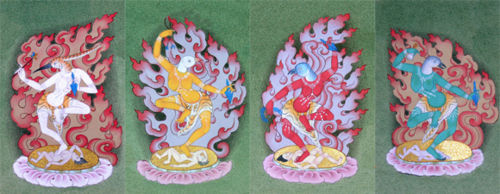Twenty-eight ishvaris: Difference between revisions
No edit summary |
No edit summary |
||
| Line 1: | Line 1: | ||
The '''twenty-eight ishvaris''' (Skt. ''īśvarī''; Tib. ''wangchukma nyer gyé''; [[Wyl.]] ''dbang phyug ma nyer brgyad'') <noinclude> are | The '''twenty-eight ishvaris''' (Skt. ''īśvarī''; Tib. ''wangchukma nyer gyé''; [[Wyl.]] ''dbang phyug ma nyer brgyad'') <noinclude> are found in [[Mahayoga]] mandalas, such as the [[fifty-eight wrathful deities]], and are also considered as samaya-bound guardians in forms brought about by their own past actions. [[Yukhok Chatralwa Chöying Rangdrol]] explains the latter term by saying that such guardians "transcend the world and yet still appear in worldly forms created by their past [[karma]] and [[disturbing emotions]] like ordinary worldly beings. For example, when Vajra Manushya Rakshasi was the wife of Ravana, king of the [[Rakshasa]]s, she had the face of a rakshasi, but then when she was abducted by [[Rudra]], she transformed her rakshasi face into that of a yak."</noinclude> | ||
The twenty-eight ishvaris are composed of four groups of six [[yogini]]s corresponding to the [[four activities]], and of the four female outer-gate keepers: | The twenty-eight ishvaris are composed of four groups of six [[yogini]]s corresponding to the [[four activities]], and of the four female outer-gate keepers: | ||
Revision as of 08:28, 29 May 2009
The twenty-eight ishvaris (Skt. īśvarī; Tib. wangchukma nyer gyé; Wyl. dbang phyug ma nyer brgyad) are found in Mahayoga mandalas, such as the fifty-eight wrathful deities, and are also considered as samaya-bound guardians in forms brought about by their own past actions. Yukhok Chatralwa Chöying Rangdrol explains the latter term by saying that such guardians "transcend the world and yet still appear in worldly forms created by their past karma and disturbing emotions like ordinary worldly beings. For example, when Vajra Manushya Rakshasi was the wife of Ravana, king of the Rakshasas, she had the face of a rakshasi, but then when she was abducted by Rudra, she transformed her rakshasi face into that of a yak."
The twenty-eight ishvaris are composed of four groups of six yoginis corresponding to the four activities, and of the four female outer-gate keepers:
- The six yoginis corresponding to the activity of pacifying:
- Rakshasi (white)
- Brahmi
- Mahadevi
- Lobha
- Kumari
- Indrani
- The six yoginis corresponding to the activity of increasing:
- Vajra
- Shanti
- Amrita
- Chandra
- Danda
- Rakshasi (dark yellow)
- The six yoginis corresponding to the activity of magnetizing:
- Bhakshini
- Rati
- Mahabala
- Rakshasi (pale red)
- Kama
- Vasuraksha
- The six yoginis corresponding to the activity of subjugating:
- Vayudevi
- Nari
- Varahi
- Nanda
- Mahahastini
- Varunadevi
- The last group is composed of the four female outer-gate keepers.




